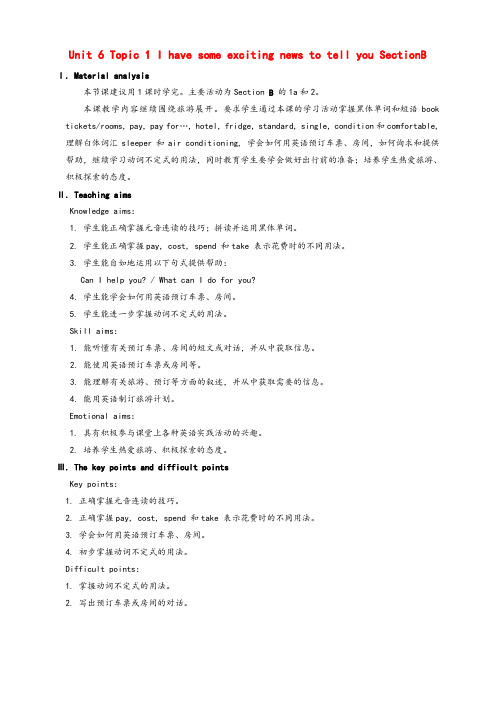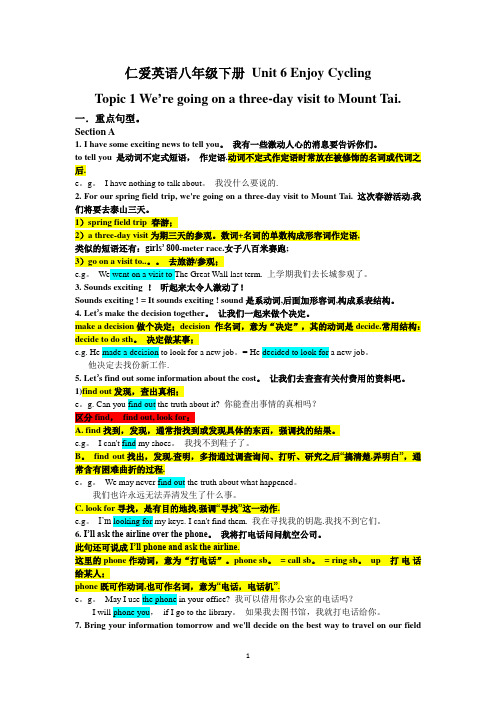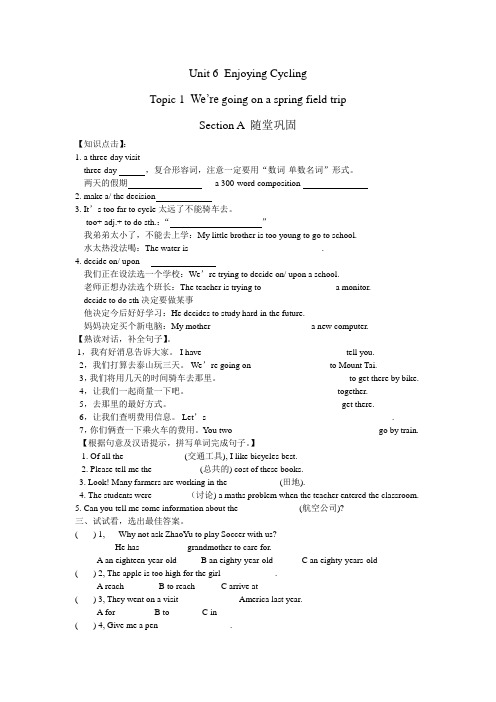仁爱初中英语八下《Unit 6Topic 1 I have some exciting news to tell you.》word教案C .doc
- 格式:doc
- 大小:158.50 KB
- 文档页数:7

《仁爱版英语八年级下册Unit6单元复习学案(附答案)》摘要:拍照,, 停止 , 继续等., unless you work much harder.Unit6 Enjoy Cycling复习学案:Topic 1 I have some exciting news to tell you.重点词组作出决定决定某事决定做某事查找付钱想出筹钱期待拍照收到某人来信检测:1. There are many kinds of (交通工具) crossing in front of my house.2. They are selling old books and newspaper (raise) money .3. Let’s decide on a [?pr?p?(r)] way to travel to Mount Tai.4. I want to rent a (comfort) house with a small garden.5. A [?st?nd?d] room costs 200 yuan a night in this hotel.6. Please p for the train tickets before 5:00 pm tomorrow.7. It’s very [?k?m?n] to raise money in American schools.8. Which kind of sleeper do you want, hard sleeper or s sleeper?9. -What’s the total p of these tickets? -300yuan.10 I am looking forward to (hear) from you.重点句型1. I have some exciting news to tell you.我有一些令人激动的消息告诉你们。

Unit 6 Topic 1 I have some exciting news to tell you SectionB Ⅰ. Material analysis本节课建议用1课时学完。
主要活动为Section B的1a和2。
本课教学内容继续围绕旅游展开。
要求学生通过本课的学习活动掌握黑体单词和短语book tickets/rooms, pay, pay for…, hotel, fridge, standard, single, condition和comfortable, 理解白体词汇sleeper和air conditioning, 学会如何用英语预订车票、房间,如何询求和提供帮助,继续学习动词不定式的用法,同时教育学生要学会做好出行前的准备;培养学生热爱旅游、积极探索的态度。
Ⅱ. Teaching aimsKnowledge aims:1. 学生能正确掌握元音连读的技巧;拼读并运用黑体单词。
2. 学生能正确掌握pay, cost, spend 和take 表示花费时的不同用法。
3. 学生能自如地运用以下句式提供帮助:Can I help you? / What can I do for you?4. 学生能学会如何用英语预订车票、房间。
5. 学生能进一步掌握动词不定式的用法。
Skill aims:1. 能听懂有关预订车票、房间的短文或对话,并从中获取信息。
2. 能使用英语预订车票或房间等。
3. 能理解有关旅游、预订等方面的叙述,并从中获取需要的信息。
4. 能用英语制订旅游计划。
Emotional aims:1. 具有积极参与课堂上各种英语实践活动的兴趣。
2. 培养学生热爱旅游、积极探索的态度。
Ⅲ. The key points and difficult pointsKey points:1. 正确掌握元音连读的技巧。
2. 正确掌握pay, cost, spend 和take 表示花费时的不同用法。

仁爱英语八年级下册Unit 6 Enjoy Cycling Topic 1 We’re going on a three-day visit to Mount Tai.一.重点句型。
Section A1.I have some exciting news to tell you。
我有一些激动人心的消息要告诉你们。
to tell you 是动词不定式短语,作定语.动词不定式作定语时常放在被修饰的名词或代词之后.e。
g。
I have nothing to talk about。
我没什么要说的.2.For our spring field trip, we're going on a three-day visit to Mount Tai. 这次春游活动,我们将要去泰山三天。
1)spring field trip 春游;2)a three-day visit为期三天的参观。
数词+名词的单数构成形容词作定语,类似的短语还有:girls’ 800-meter race.女子八百米赛跑;3)go on a visit to..。
去旅游/参观;e.g。
We went on a visit to The Great Wall last term. 上学期我们去长城参观了。
3.Sounds exciting !听起来太令人激动了!Sounds exciting ! = It sounds exciting ! sound是系动词,后面加形容词,构成系表结构。
4.Let’s make the decision together。
让我们一起来做个决定。
make a decision做个决定;decision 作名词,意为“决定”,其的动词是decide.常用结构:decide to do sth。
决定做某事;e.g. He made a decision to look for a new job。
= He decided to look for a new job。

Unit 6 Enjoying CyclingTopic 1 We’re going on a spring field tripSection A 随堂巩固【知识点击】:1. a three-day visitthree-day ,复合形容词,注意一定要用“数词-单数名词”形式。
两天的假期 a 300-word composition2. make a/ the decision3. It’s too far to cycle 太远了不能骑车去。
too+ adj.+ to do sth.:“”我弟弟太小了,不能去上学:My little brother is too young to go to school.水太热没法喝:The water is ______________________________.4. decide on/ upon我们正在设法选一个学校:We’re trying to decide on/ upon a school.老师正想办法选个班长:The teacher is trying to ________________ a monitor.decide to do sth 决定要做某事他决定今后好好学习:He decides to study hard in the future.妈妈决定买个新电脑:My mother ______________________ a new computer.【熟读对话,补全句子】。
1,我有好消息告诉大家。
I have ________________________________ tell you.2,我们打算去泰山玩三天。
We’re going on _________________ to Mount Tai.3,我们将用几天的时间骑车去那里。
_____________________________ to get there by bike. 4,让我们一起商量一下吧。

Unit 6 Enjoying Cycling Topic1 I have some exciting news to tellyou SectionBⅠ. Material analysis本节课建议用1课时学完。
主要活动为Section B的1a和2。
本课教学内容继续围绕旅游展开。
要求学生通过本课的学习活动掌握黑体单词和短语book tickets/rooms, pay, pay for…, hotel, fridge, standard, single, condition和comfortable, 理解白体词汇sleeper和air conditioning, 学会如何用英语预订车票、房间,如何询求和提供帮助,继续学习动词不定式的用法,同时教育学生要学会做好出行前的准备;培养学生热爱旅游、积极探索的态度。
Ⅱ. Teaching aimsKnowledge aims:1. 学生能正确掌握元音连读的技巧;拼读并运用黑体单词。
2. 学生能正确掌握pay, cost, spend 和take 表示花费时的不同用法。
3. 学生能自如地运用以下句式提供帮助:Can I help you? / What can I do for you?4. 学生能学会如何用英语预订车票、房间。
5. 学生能进一步掌握动词不定式的用法。
Skill aims:1. 能听懂有关预订车票、房间的短文或对话,并从中获取信息。
2. 能使用英语预订车票或房间等。
3. 能理解有关旅游、预订等方面的叙述,并从中获取需要的信息。
4. 能用英语制订旅游计划。
Emotional aims:1. 具有积极参与课堂上各种英语实践活动的兴趣。
2. 培养学生热爱旅游、积极探索的态度。
Ⅲ. The key points and difficult pointsKey points:1. 正确掌握元音连读的技巧。
2. 正确掌握pay, cost, spend 和take 表示花费时的不同用法。

仁爱版英语八下Unit 6 Topic 1《I have some eciting news to tell you》(SectionC》教学设计一. 教材分析教材为仁爱版英语八年级下册,Unit 6 Topic 1的主题为“I have some exciting news to tell you”。
本节课主要讨论节日和活动,通过介绍中国的传统节日和活动,让学生了解中国文化,同时提高学生的听说读写能力。
二. 学情分析学生已经学习了前面五个单元,具备一定的英语基础。
对于本节课的主题,学生可能对中国传统节日和活动有一定的了解,但需要通过课堂学习,提高他们的语言表达能力。
三. 教学目标1.知识目标:学生能够掌握与节日和活动相关的词汇和表达方式,如“Dragon Boat Festival”、“Lantern Festival”等。
2.能力目标:学生能够用英语描述中国的传统节日和活动,提高他们的听说读写能力。
3.情感目标:通过学习,学生能够了解中国文化的博大精深,增强对祖国的热爱之情。
四. 教学重难点1.重点:学生能够掌握与节日和活动相关的词汇和表达方式。
2.难点:学生能够用英语描述中国的传统节日和活动,提高他们的语言表达能力。
五. 教学方法采用任务型教学法,通过创设情境,引导学生参与课堂活动,提高他们的听说读写能力。
同时,运用小组合作学习,培养学生的团队精神和自主学习能力。
六. 教学准备1.教师准备:制作课件,准备相关节日的图片和视频资料。
2.学生准备:预习相关内容,搜集有关中国节日的资料。
七. 教学过程1.导入(5分钟)教师通过提问方式,引导学生谈论他们所知道的节日,如“春节”、“中秋节”等。
同时,教师展示相关节日的图片,帮助学生回忆和巩固已学知识。
2.呈现(10分钟)教师展示本节课的主题“I have some exciting news to tell you”,并向学生介绍中国的传统节日和活动。
仁爱版英语八下Unit 6 Topic 1《I have some eciting news to tell you》(SectionA》教案一. 教材分析本节课选自仁爱版英语八年级下册Unit 6 Topic 1 Section A。
本节课主要讨论了关于新闻的话题,通过学习,学生能够掌握如何表达新闻的内容以及如何询问和表达对于新闻的看法。
本节课的主要语言点包括:一般现在时的被动语态、常用短语以及如何表达对于某件事情的看法。
二. 学情分析学生在之前的学习中已经掌握了一般现在时、现在进行时和现在完成时等时态,对本节课的一般现在时的被动语态的语言点有一定的认知基础。
但对于如何表达对于新闻的看法,可能还需要进一步的引导和练习。
三. 教学目标1.知识目标:–能正确运用一般现在时的被动语态表达新闻的内容。
–能运用常用短语询问和表达对于新闻的看法。
2.能力目标:–能流利地朗读和表演新闻报道。
–能在适当的场合运用本节课学到的语言点进行交流。
3.情感目标:–培养学生对于新闻的兴趣,提高学生关注时事的能力。
四. 教学重难点•一般现在时的被动语态的运用。
•常用短语的掌握。
•如何表达对于新闻的看法。
五. 教学方法采用情境教学法、交际法、任务型教学法等,通过设定情境、小组讨论、角色扮演等方式,激发学生的学习兴趣,提高学生的语言运用能力。
六. 教学准备1.教材:仁爱版英语八年级下册Unit 6 Topic 1 Section A。
2.多媒体设备:电脑、投影仪等。
3.教学素材:相关新闻的视频或图片。
七. 教学过程1.导入(5分钟)–教师通过播放一段新闻视频或展示一组新闻图片,引导学生谈论新闻话题。
–学生分享自己喜欢的新闻,并简单介绍新闻的内容。
2.呈现(10分钟)–教师通过PPT展示本节课的主要内容,包括新闻报道的文本和图片。
–教师引导学生关注新闻的标题、导语和主体部分,引导学生理解新闻的内容。
3.操练(10分钟)–教师学生进行小组讨论,让学生模拟新闻报道的过程,练习使用一般现在时的被动语态和常用短语。
Miss Wang Boys and girls,I have some excitingnews to tell you!For our spring field trip,We're going on a three-day visit to Mount Tai .王老师:同学们,我有一些好消息要告诉你们!我们春游要去泰山旅游三天。
Maria Wow,how wonderful!How shall we get there?马丽亚:哇哦,太棒了!我们要怎么去呢?Michael Shall we cycle there?迈克尔:我们能骑自行车去吗?Kangkang Sounds exciting!But it will take us a few days to get there by bike .康康:听起来很棒!但是骑自行车要花几天才能到。
Miss Wang Let's make the together .It's too far to cycle,but we can choose proper .王老师:我们一起来做决定。
骑自行车太远了,不过我们可以选择合适的交通工具。
Jane Yes . Let's decide .简:是的。
我们来决定吧。
Michael Let's find out some information about the cost .迈克尔:我们先来看看费用的事。
Miss Wang OK .Kangkang and Michael,you two find the cost for the train .Helen,you need to find the cost for the bus .王老师:好的。
康康,迈克尔,你们两个询问火车票价。
海伦,你找到公车的价格。
Jane I'd love to go by I'll ask the airline over the phone .简:Miss Wang OK .Bring your information tomorrow and we'll decide on the best way to travel on our field trip .王老师:好的。
Topic1 教材知识详解1. I have some exciting news to tell you.我有些好消息要告诉你们。
to tell you是动词不定式,作定语,修饰news。
动词不定式作定语时要放在所修饰的名词或代词之后。
如:I have nothing to say.我没什么要说的。
Could you give me something to eat?你能给我点吃的东西吗?2.For our spring field trip, we’re going on a three-day visit to Mount Tai.这次春游,我们将去泰山玩三天。
①go on a visit意为“去旅游”,visit作名词。
如:They will go on a visit to the West Lake this Sunday.这个星期天他们将去西湖旅游。
visit探望,拜访;参观,游览。
如:I visited one of my old friends yesterday.昨天我拜访了一位老朋友。
We will visit the Great Wall next month.下个月我们将去游长城。
②a three-day visit意为“一次三天的旅游”,three-day是复合形容词,作定语,其结构为:数词+连字符+单数名词。
如:a seven-day holiday 一个七天的假期an eight-year-old boy 一名八岁男孩3. Let’s find out some information about the cost.让我们查一下有关费用的信息。
find out(通过询问、读或看等方式)查明,弄清(情况)。
如:Can you find out what time the train leaves?你能查清楚火车什么时候开吗?【链接】find的用法:①(意外或偶然地)发现,碰到。
仁爱英语八年级下册Unit6EnjoyCyclingTopic1We’regoingonathree-dayvisittoMountTai.一.重点句型。
SectionA1.Ihavesomeexcitingnewstotellyou.我有一些激动人心的消息要告诉你们。
totellyou是动词不定式短语,作定语。
动词不定式作定语时常放在被修饰的名词或代词之后。
e.g.Ihavenothingtotalkabout.我没什么要说的。
2.Forourspringfieldtrip,we’regoingonat hree-dayvisittoMountTai.这次春游活动,我们将要去泰山三天。
1)springfieldtrip春游;2)athree-dayvisit为期三天的参观。
数词+名词的单数构成形容词作定语,类似的短语还有:girls’800-meterrace.女子八百米赛跑;3)goonavisitto....去旅游/参观;e.g.WewentonavisittoTheGreatWalllastterm.上学期我们去长城参观了。
3.Soundsexciting!听起来太令人激动了!Soundsexciting!=Itsoundsexciting!sound是系动词,后面加形容词,构成系表结构。
4.Let’smakethedecisiontogether.让我们一起来做个决定。
makeadecision做个决定;decision作名词,意为“决定”,其的动词是decide。
常用结构:decidetodosth.决定做某事;e.g.Hemadeadecisiontolookforanewjob。
=Hedecidedtolookforanewjob.他决定去找份新工作。
5.Let’sfindoutsomeinformationaboutthecost.让我们去查查有关付费用的资料吧。
1)findout发现,查出真相;e.g.Canyoufindoutthetruthaboutit?你能查出事情的真相吗?区分find,findout,lookfor:A.find找到,发现,通常指找到或发现具体的东西,强调找的结果。
Unit 6 Enjoying Cycling Topic1 I have some exciting news totell you SectionC本节课建议用1课时学完。
主要活动为Section C 的1a和2。
本课教学内容围绕谈论如何为旅游筹钱展开。
要求学生通过本课的学习活动掌握黑体单词和短语raise, raise money, king, queen, common, Canadian, dollar 和look forward to doing sth. , 继续学习动词不定式的用法,通过了解外国学生怎样筹集旅游资金,学会如何积极与他人协作,共同完成任务。
Knowledge aims:1. 学生能正确拼读并运用黑体单词。
2. 学生能正确掌握look forward to doing sth. 的用法。
3. 学生能进一步掌握动词不定式的用法。
Skill aims:1. 能听懂有关筹钱方式的短文或对话,并从中获取信息。
2. 能使用英语来介绍自己筹钱的方式。
3. 能理解有关筹钱方面的叙述,并从中获取需要的信息。
4. 能用英语写出有关筹钱方式的短文。
Emotional aims:具有积极参与课堂上各种英语实践活动的兴趣。
Key points:1. 正确掌握look forward to doing sth. 的用法。
2. 掌握动词不定式的用法。
Difficult points:1. 掌握动词不定式的用法。
2. 写出有关筹钱方式的短文。
Ⅳ. Learning strategi es1. 善于创设情景,在情景中提高语言交际能力,突显语言交际功能。
2. 善于根据图片预测短文大意,并根据语言环境等猜测新单词的意思。
Computer multimedia projector.Step InteractionpatternStudent activity Teacher activityIntroduction (8 minutes)1. The wholeclass work.2. The wholeclass work.3. The wholeclass work.4. Groupwork.5. The wholeclass work.6. The wholeclass work.class work.1. Students focustheirattention on theteacher.2. Studentsreport theirhomework.answer: We can getmoney from ourparents.4. Students discussingroups.5. Students showtheirideas.6. Students check for1a.7. Students telltheiranswers.students and make them readyfor learning.2. Theteacher asks thestudents to reporttheirhomework. Let thestudentsconversation of1a in Section 3. Theteacher guides thestudents to answer thequestion: We all liketraveling, but it willcost us much money togo on a trip. How canyou get money?4. The teacher leads thestudents to discuss ingroups: “In Canadaandmake money by themselves.5. The teacher asks thestudents to use “Wecando sth. to raisemoney” toshow their ideas.6. The teacher asks thestudents to check“whatyou usually do toraisemoney for a fieldtrip” for1a.7. The teacher asks twostudents to tell theiranswers.underline in their passagefind out theConsolidati on(10 minutes)class work.class work.class work.class work.class work.The wholeclass workandpair work.8. The wholeclass work.Students read thepassageafter therecordingsentence bysentence.Students try to followthe speed, payingattention to thepronunciation 3.Students read 1aandput the sentencesin the right order.answers with theteacher.structure to + v. intheconversation.6. Volunteers telltheiranswers.7. Students read 1aandfind out the keywords.8. Students retellthepassage accordingtothe key words.1. The teacher plays therecording sentence bysentence.2. The teacher plays therecording withoutstopping.3. The teacher lets thestudents read 1a againand put the sentences of1c in the right order.4. The teacher lets twostudentscheck the answers.5. Theteacher asks thestudents to find out thestructure to + v.in thepassage.6. The teacher lets twostudents tell theiranswers, and understandthe sentences withinfinitives.7. The teacher asks thestudents to read 1a, andfind out the key words toprepare for retelling of1a.8. The teacher asks thestudentsto retell the passageaccording tothe key words:(1) common to raise money(2) special ways to …(3) think of …(4) buy a ticket for thedraw(5) be the king or queen(6) headmaster greets…(7) use theheadmaster’s(8) cel lphone to …Practice (10 minutes) 1. The wholeclass work.2. The wholeclass work.3. The wholeclass work.4. The wholeclass work.5. The wholeclass work.6. The wholeclass work.1. Students read 2 andguessthe meaning of the newword.2. Students tell theirguess,and read 2 to completethe letter.3. their answers ontheblackboard. Thestudents check theanswers with theteacher.4. Students read thewholeletter, and findout theinfinitives and thedifficulties in the5. Students read thesentencesof 3a and look at thepictures.6. Students tell theiranswers with theteacher.1. The teacher asks thestudents to read 2 andguess the meaning of thenew word forward2. The teacher asks thestudents to tell theanswer, and then read 2again, then complete theletter with the correctforms of the givenwords.3. The teacher asks fourstudents to write theanswers on theblackboard.4. The teacher asks theLet them find out theinfinitives and thedifficulties in theletter, and solve theproblems. Teach the newword and the phraseforward,look forwardto doing sth.The teacher lets thestudentsread thesentences of 3a,and look at thepictures, atlast match the ideaswiththe pictures.6. The teacher lets twoorthree students telltheiranswers. Grasp theusageof infinitives.Production(7 minutes) 1. The wholeclass workandgroup work.2. The wholeclass work.3. Individualwork.groups and finishthepassage.2. Students summarizeSection C with theteacher.homework after class.1. The teacher organizesthestudents to write apassageaccording to3a.(1) Ask the students todiscuss in groups:Which(2) Ask each group towrite down the keywordsafter choosing onecertainAsk them to writeapassage their ownideas.(4) Ask some studentsfrom differentgroupsto read theirpassages.The teachersummarizes2. Theteacher shows thesummary to the students.homework:(1) Review the summaryafter class.Ask the students towritea passage about howto raise money.(3) Prepare Section Dafter class.。